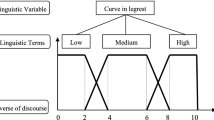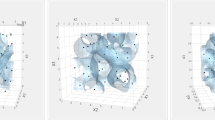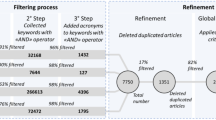Abstract
The demand for high-quality and low-cost products with short development time in the dynamic global market has forced researchers and industries to focus on various effective product development strategies. The authors are carrying out research studies to explore the applicability of fuzzy logic and knowledge-based systems technologies to today’s competitive product design and development, with an emphasis on the design of high quality products at the conceptual design stage. A framework of a fuzzy FMEA (failure modes and rffects analysis) based evaluation approach for new product concepts is proposed in this paper. Based on the proposed approach and methodologies, a prototype system named EPDS-1, which can assist inexperienced users to perform FMEA analysis for quality and reliability improvement, alternative design evaluation, materials selection, and cost assessment, thus helping to enhance robustness of new products at the conceptual design stage. This paper presents the underlying concepts of the development and shows the practical application with the prototype system with a case study.
Similar content being viewed by others
References
Adenso-Diaz B, Gonzalez I, Tuya J (2004) Incorporating fuzzy approaches for production planning in complex industrial environments: the roll shop case. Eng Appl Artif Intell 17:73–81
Akao Y (1990) Quality function deployment: integrating customer requirements into product design. Productivity Press, Cambridge Press
Ammar S, Duncombe W, Jump B, Wright R (2004) Constructing a fuzzy knowledge-based system: an application for assessing the financial condition of public schools. Expert Syst Appl 27:349–364
Antonsson EK, Otto KN (1995) Imprecision in engineering design. ASME J Mech Des 17(2):25–32
Biren P (1996) Concurrent engineering fundamentals: integrated product and process organization. Prentice Hall, Englewood Cliffs, NJ
Bovea MD, Wang B (2003) Identifying environment improvement options by combining life cycle assessment and fuzzy set theory. Int J Prod Res 41(3):593–609
Bowles JB, Peláez CE (1995) Fuzzy logic prioritization of failures in a system failure mode, effects and criticality analysis. Reliability Engineering and System Safety 50:203–213
Braglia M, Frosolini M, Montannari R (2003) Fuzzy criticality assessment model for failure modes and effect analysis. Int J Qual Reliab Manage 20(4):503–524
Chin KS, Wong TN (1996) Knowledge-based evaluation for the conceptual design development of injection moulding parts. Eng Appl Artif Intell 9(4):359–376
Chin KS, Lam J, Chan JKF, Poon PKK, Yang JB (2005) A CIM-OSA presentation of an integrated product design review framework. Int J Comput Integr Manuf 84(4):260–278, June
Chiu YC, Shyu JZ, Tzeng GH (2004) Fuzzy MCDM for Evaluating the E-commerce Strategy. Int J Comput Appl Technol 19(1):12–22
Cinquegrana DA (1990) Knowledge-based injection mold design automation, PhD Thesis, University of Lowell
Cohen L (1995) Quality function deployment. Addison-Wesley, Reading, Massachusetts
Diaz-Hermida F, Losada DE, Bugarin A, Barro S (2005) A probabilistic quantifier fuzzification mechanism: the model and its evaluation for information retrieval. IEEE Trans Fuzzy Syst 13(5):688–700
Dixon JR (1995) Knowledge-based systems for design. J Mech Des 117:11–16
Du X, Chen W (2000) Concurrent subsystem uncertainty analysis in multidisciplinary design. 8th AIAA/NASA/USAF/ISSMO Symposium on Multidisciplinary Analysis and Optimization, Long Beach, CA, AIAA, AIAA-00–4928 pp 82–89
Fay A (2000) A fuzzy knowledge-based system for railway traffic control. Eng Appl Artif Intell 13:719–729
Franceschini F, Galetto M (2001) A new approach for evaluation of risk priorities of failure modes in FMEA. Int J Prod Res 39(13):2991–3002
Garcia AA, Schirru R, Melo PF (2005) A fuzzy DEA approach for FMEA. Profess in Nuclear Energy 46(3–4):359–373
Gien D, Jacqmart S, Seklouli A, Barad M (2003) An approach based on fuzzy sets for manufacturing system design. Int J Prod Res 41(2):315–335
Hawkins PG, Woollons DJ (1998) Failure mode and effects analysis of complex engineering systems using functional models. Artificial Intelligence Engineering. 12:375–397
Knoglu A, Arditi D (2004) An integrated automation system for design/build organizations. Int J Comp Appl Technol 20(1–3):3–14
Lalla TRM, Lewis WG, Pun KF, Chin KS, Lau HCW (2003) Manufacturing strategy, total quality management and performance measurement: an integrated model. Int J Manuf Technol Manag 5(5/6):414–427
Lau HCW, Wong CWY, Lau PKH, Pun KF, Chin KS, Jiang B (2003) A fuzzy multi-criteria decision support procedure for enhancing information delivery in extended enterprise networks. Eng Appl Artif Intell 16:1–9
Li DC, Wu CS, Chang FMM (2005) Using data-fuzzification technology in small data set learning to improve FMS scheduling accuracy. Int J Adv Manuf Technol 27(3–4):321–328
Liao TW (2004) An investigation of a hybrid CBR method for failure mechanisms identification. Eng Appl Artif Intell 17:123–134
Mendil B, Benmahammed K (2001) Activation and defuzzification methods for fuzzy rule-based systems. J Intell Robot Syst 32(4):437–444
Metaxiotis K, Ergazakis K, Samouilidis E, Psarras J (2004) Decision support through knowledge management: the role of artificial intelligence. Int J Comp Appl Technol 19(2):101–112
Mohamed A, Celik T (2002) Knowledge-based system for alternative design, cost estimating and scheduling. Knowl-Based Syst 15:177–188
Mok CK, Chin KS, Ho JKL (2001) An interactive knowledge-based CAD system for mould design in injection moulding processes. Int J Adv Manuf Technol 17:27–38
Myint S, Tabucannon MT (1998) The framework for an expert system to generate alternative products in concurrent engineering design. Comput Ind 37(2):125–134
Ong SK, Prombanpong S, Lee KS (1995) An object-oriented approach to computer-aided design of a plastic injection mould. J Intell Manuf 6:1–10
Ong YS, Keane AJ (2002) A domain knowledge based search advisor for design problem solving environments. Eng Appl Artif Intell 15:105–116
Opricovic S, Tzeng GH (2003) Defuzzification within a multicriteria decision model. Int J Uncertain Fuzziness Knowl-based Syst 11(5):635–652
Ratchev S, Urwin E, Muller D, Pawar KS, Moulek I (2003) Knowledge based requirement engineering for one-of-a-kind complex systems. Knowl-Based Syst 16:1–5
Roychowdhury S, Pedrycz W (2001) A survey of defuzzification strategies. Int J Intell Sys 16(6):679–695
Saade JJ, Diab HB (2000) Defuzzification techniques for fuzzy controllers. IEEE Trans Syst Man Cybern, Part B, Cybern 30(1):223–229
Sapuan SM (2001) A knowledge-based system for materials selection in mechanical engineering design. Materials and Design 22:687–695
Shin HY, Lee JW (1998) An expert system for pneumatic design. AI EDAM 12(1):3–11
Takahashi I (1996) Product design review. Productivity Press, USA pp 3–13
Tam SM, Kwong CK, Ip WH (2000) A hybrid artificial intelligence system for optical lens design. Int J Comput Appl Technol 13(3/4/5):229–236
Teng SH, Ho SY (1996) Failure mode and effects analysis: an integrated approach for product design and process control. Int J Qual Reliab Manage 13(5):8–26
Teoh PC, Case K (2004) FMEA through knowledge modeling. J Mater Process Technol 153:253–260
Teoh PC, Case K (2005) An evaluation of failure modes and effect analysis generating method for conceptual design. Int J Comput Integr Manuf 18(4):279–293
Vaghul M (1985) Expert systems in CAD environment: injection molding part as an example in computer in engineering, Proceedings of 1985 ASME Design Conference, New York, USA, Vol. 2, pp 77–82
Venter G, Haftka RT (1998) Using response surface methodology in fuzzy set based design optimization, 39th AIAA/ASME/ASCE/AHS/ASC Structures, Structural Dynamics and Materials Conference, Long Beach, CA, AIAA, AIAA-98–1776, pp 641–652, 1998
Wang JC, Terpenny J (2003) Interactive evolutionary solution synthesis in fuzzy set-based preliminary engineering design. J Intell Manuf 14(2):153–167
Xu K, Tang LC, Xie M, Ho SL, Zhu ML (2002) Fuzzy assessment of FMEA for engine systems. Reliab Eng Syst Saf 75(1):17–29
Yager RR, Filev DP (1993) On the issue of defuzzifiztion and selection based on fuzzy set. Fuzzy Sets Syst 55:255–271
Zadeh L (1965) ‘Fuzzy sets’, Inf Control 8:338–353
Zadeh L (1992) The calculus of fuzzy if-then rules. AI Expert 7:23–27
Zha XF (2002) A knowledge intensive multi-agent framework for cooperative/collaborative design modeling and decision support of assemblies. Knowl-Based Sys 15:493–506
Zheng LY, Chin KS, Wei L (2002) Knowledge-enriched process FMEA model for process planning. The Asian Journal on Quality 3(1):12–27, June
Zimmerman HJ (1990) Fuzzy sets and systems: theory and applications. Kluwer Academic Publishers, Boston, USA
Author information
Authors and Affiliations
Corresponding author
Rights and permissions
About this article
Cite this article
Chin, KS., Chan, A. & Yang, JB. Development of a fuzzy FMEA based product design system. Int J Adv Manuf Technol 36, 633–649 (2008). https://doi.org/10.1007/s00170-006-0898-3
Received:
Accepted:
Published:
Issue Date:
DOI: https://doi.org/10.1007/s00170-006-0898-3




